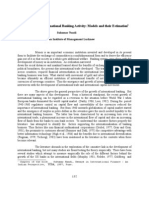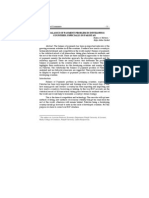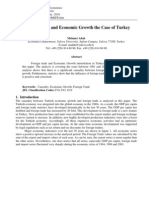Measuring The Underground Economy: Data and Methodology
Measuring The Underground Economy: Data and Methodology
Uploaded by
Ayesha RehmanCopyright:
Available Formats
Measuring The Underground Economy: Data and Methodology
Measuring The Underground Economy: Data and Methodology
Uploaded by
Ayesha RehmanOriginal Title
Copyright
Available Formats
Share this document
Did you find this document useful?
Is this content inappropriate?
Copyright:
Available Formats
Measuring The Underground Economy: Data and Methodology
Measuring The Underground Economy: Data and Methodology
Uploaded by
Ayesha RehmanCopyright:
Available Formats
Bushra Yasmin and Hira Rauf
93
Measuring the Underground Economy
Data and Methodology The measurement of the underground economy has been the subject of intense debate in the literature. Some authors have used the direct method to assess the underground economy while some others have attempted an indirect method, known as the non-monetary approach and monetary approach, respectively.3 This study follows the monetary approach based on a monetary indicator and in particular the amount of currency in circulation. This approach basically originates from the model of Tanzi (1983). The approach is applied with three main assumptions. First, the underground economy is generated through tax evasion. Second, currency alone is used as a medium to carry out transactions in the underground economy. Third, velocity of illegal money is same as that of legal money. In the estimation procedure, first the currency demand equation is estimated with the justification that most of the transactions are carried out in the form of cash in the underground economy in order to reduce the chances of detection. The demand for currency is measured by the ratio of currency in circulation (CC) to M2 definition of money supply. The following is the model applied to estimate the currency demand equation. (CC/M2 )t = 1 + 2 (T/Y )t-1 + 3 (BS ) + 4 (INT )t-1 + 5 (Yg )+ 6 (CC/M2 )t-1 + I Table 1 provides the details about the variables, definition and its resources, used in equation I.
Monetary approach refers to the currency ratio, the modified currency ratio, transaction method and big bill phenomenon while non-monetary approach depends on labour market studies, difference between income and expenditure and the soft modeling approach.
3
94
The Lahore Journal of Economics, Vol.9, No.2
Table 1: Definition of Variables Variabl es CC Definitions Currency in circulation equals currency issued, currency held by the State Bank of Pakistan and currency in tills of scheduled banks measured in million rupees. Sources Pakistan, State Bank of (2002).
M2
Money supply is measured as Pakistan, currency in circulation, banks State Bank demand deposits, scheduled banks of (2002). time deposits & other deposits with State Bank of Pakistan measured in million rupees. Total taxes is measured by adding up the direct taxes that includes taxes on income, wealth tax, workers welfare tax and indirect tax that includes custom duties, federal excise duties and sales tax, measured in million rupees. Interest rate on time deposits taken as weighted average rates pertain to other than PLS deposits. These rates are percentage per annum. Pakistan, Governme nt of (2002).
INT
Pakistan, State Bank of (2002).
Gross Domestic Product is defined as the value of all goods and services produced in the economy, measured in million rupees. Banking services defined as ratio of bank deposits to total number of bank accounts measured in million rupees.
Pakistan, Governme nt of (2002). Pakistan, State Bank of (2002).
BS
Yg
Growth rates in real per capita GDP Pakistan, measured in million rupees. Governme nt of
Bushra Yasmin and Hira Rauf
95
(2002). The data used for estimating the underground economy covers the period 1974-2002. The justification of variables along with their expected signs in the currency demand equation is given below. After estimating the currency demand equation, the size of the UGE through tax evasion is gauged. The procedure for estimating the size is as follows; Illegal Money (IM) = [(CC/M2)t - (CC/M2)wt ] * M2 Legal money (LM) = M1 - IM Velocity of money (IV) = GDP/LM Underground Economy (UGE) = IM * IV Tax evasion (TE) = UGE * (T/GDP) First, the values of the currency ratio for each year with and without tax variables are predicted by using the preceding regression equation. The difference between the two is multiplied by the total value of M2 for the respective years in order to find out the level of illegal money as given in the above notations. Following Tanzi (1983), the difference between total money supply (M2) and the estimated illegal money gives legal money (LM). Dividing the Gross Domestic National Product (GDP) by legal money gives an estimate of the income velocity of legal money. Further, illegal money is multiplied with velocity of money to get an estimate of the underground economy. Finally, the level of tax evasion is calculated by multiplying estimates of the underground economy with the ratio of overall taxes to GDP. After measuring the size of the underground economy and tax evasion, an Ordinary Least Square model is applied to find out the impact of UGE and TE on GDP. Following are the equations used for estimation.
96
The Lahore Journal of Economics, Vol.9, No.2
GDPt = 0 + 1 TEt + 2 GDPt-1 + GDPt = 3 + 4 UGEt + 5 GDPt-1 + III
II
Where, GDP stands for real gross domestic product, TE for tax evasion, UGE for underground economy and GDPt-1 for one year lagged GDP, all measured in million rupees.
You might also like
- CreditsecretsandloopholesDocument139 pagesCreditsecretsandloopholesAnthony Roberts60% (5)
- Hinduja GroupDocument4 pagesHinduja GroupShivanshu GuptaNo ratings yet
- Kashato ShirtsDocument40 pagesKashato ShirtsLiana Abad100% (3)
- 0619-E Jan 2018 Rev Final - FFDocument1 page0619-E Jan 2018 Rev Final - FFthis is my nameNo ratings yet
- Measuring The Underground Economy and Its Impact On The Economy of PakistanDocument11 pagesMeasuring The Underground Economy and Its Impact On The Economy of PakistanFezan AliNo ratings yet
- Underground Economy and Tax Gap: Iranian Economic Review, Vol.13, No.22, Fall 2008Document29 pagesUnderground Economy and Tax Gap: Iranian Economic Review, Vol.13, No.22, Fall 2008Cristina ParaschivNo ratings yet
- Temi Di DiscussioneDocument34 pagesTemi Di DiscussioneCristina StefanovNo ratings yet
- Estimation of The Black Economy of Pakistan Through The Monetary ApproachDocument17 pagesEstimation of The Black Economy of Pakistan Through The Monetary ApproachSyed Masroor Hussain ZaidiNo ratings yet
- The Case For XORDocument12 pagesThe Case For XORpanchalvijay0227No ratings yet
- Literature ReviewDocument14 pagesLiterature ReviewNamdev Upadhyay100% (1)
- NRB Economic Review-Vol 25-1 April 20132 Demand For Money in Nepal An ARDL Bounds Testing ApproachBirendra Bahadur BudhaDocument16 pagesNRB Economic Review-Vol 25-1 April 20132 Demand For Money in Nepal An ARDL Bounds Testing ApproachBirendra Bahadur BudhaRagnar LothbrokNo ratings yet
- 006 Homework2 FormatDocument4 pages006 Homework2 FormatSebastián Romero.No ratings yet
- Turnitin HasbiDocument13 pagesTurnitin HasbiHASBIUL HASHFINo ratings yet
- ARDL Used in EconometricsDocument6 pagesARDL Used in EconometricsBaber AminNo ratings yet
- An Empirical Analysis of Money Demand Function in Nepal: Birendra Bahadur BudhaDocument17 pagesAn Empirical Analysis of Money Demand Function in Nepal: Birendra Bahadur BudhaIsmith PokhrelNo ratings yet
- The Parallel Economy in India: Causes, Impacts and Government InitiativesDocument12 pagesThe Parallel Economy in India: Causes, Impacts and Government InitiativesRitesh AgrawalNo ratings yet
- Is-Lm ModelDocument27 pagesIs-Lm Modelgautam.bakshi7695No ratings yet
- Chapter 4 - Money & InflationDocument74 pagesChapter 4 - Money & InflationRachel DelgadoNo ratings yet
- Unit 2ndDocument42 pagesUnit 2ndBhavesh PasrichaNo ratings yet
- 3 Economic Offences and Its Impact On Economy.Document6 pages3 Economic Offences and Its Impact On Economy.Accessible IT Solutions Inc.No ratings yet
- Black MoneyDocument13 pagesBlack Moneymadhavchaturvedi9No ratings yet
- Supply of Money: Abstract: This Short Paper Is The Encyclopedia Entry On Supply of Money To Appear in TheDocument7 pagesSupply of Money: Abstract: This Short Paper Is The Encyclopedia Entry On Supply of Money To Appear in TheAnkur AhujaNo ratings yet
- Lorier.D. BSC 2Document34 pagesLorier.D. BSC 2rameshNo ratings yet
- EScholarship UC Item 6zn9p98bDocument20 pagesEScholarship UC Item 6zn9p98bHoang PhuNo ratings yet
- DemonetizationDocument45 pagesDemonetizationPradeep PrajapatiNo ratings yet
- Determinants of Exchange Rate Fluctuations For Venezuela: Application of An Extended Mundell-Fleming ModelDocument8 pagesDeterminants of Exchange Rate Fluctuations For Venezuela: Application of An Extended Mundell-Fleming ModelNavneet JaiswalNo ratings yet
- National Income It Is The Money Value of All The Final Goods and Services Produced by A Country During The Period Factors Affecting Size of Nation's IncomeDocument4 pagesNational Income It Is The Money Value of All The Final Goods and Services Produced by A Country During The Period Factors Affecting Size of Nation's IncomeTez StatusNo ratings yet
- Black Money-Part-1Document9 pagesBlack Money-Part-1silvernitrate1953No ratings yet
- Determinants Intl BankingDocument11 pagesDeterminants Intl BankingSukumar Nandi100% (2)
- Tax Evasion Policies and The Demand For Cash: June 2020Document68 pagesTax Evasion Policies and The Demand For Cash: June 2020Anonymous Asmd9ZS1kNo ratings yet
- Annotated BibliographyDocument13 pagesAnnotated BibliographyJasonMoonNo ratings yet
- 2021 Exam Guide For Macroeconomics OMBADocument8 pages2021 Exam Guide For Macroeconomics OMBAFrozenSmileNo ratings yet
- JOC Rehman Rashid 31 52Document22 pagesJOC Rehman Rashid 31 52Alee MughalNo ratings yet
- Money SupplyDocument31 pagesMoney SupplyDivya JainNo ratings yet
- Eco 101Document6 pagesEco 101Tino Valentino BorerweNo ratings yet
- Balance of Payment of PakistanDocument12 pagesBalance of Payment of PakistanKalsum FayazNo ratings yet
- tmp9501 TMPDocument5 pagestmp9501 TMPFrontiersNo ratings yet
- 3 International Trade and Investment Flows: 3.1 Global TrendsDocument20 pages3 International Trade and Investment Flows: 3.1 Global Trendslove_faz_689539677No ratings yet
- The Suntory and Toyota International Centres For Economics and Related Disciplines, The London School of Economics and Political Science, Wiley EconomicaDocument16 pagesThe Suntory and Toyota International Centres For Economics and Related Disciplines, The London School of Economics and Political Science, Wiley EconomicaAdyCastilloNo ratings yet
- Project On Parallel EconomyDocument22 pagesProject On Parallel EconomySarthak Mathur50% (2)
- The Data Collection ProcessDocument2 pagesThe Data Collection ProcessShreyasNo ratings yet
- Bhattacharya 1974Document10 pagesBhattacharya 1974Joel AbhishekNo ratings yet
- Unit 16 Equilibrium in Money Market: 16.0 ObjectivesDocument14 pagesUnit 16 Equilibrium in Money Market: 16.0 ObjectivesAjeet KumarNo ratings yet
- Central University of South Bihar: Assignment of Money and BankingDocument24 pagesCentral University of South Bihar: Assignment of Money and Bankingnirshan rajNo ratings yet
- International Economics II - CH 3Document35 pagesInternational Economics II - CH 3Ermias AtalayNo ratings yet
- Francis M CAT 4Document6 pagesFrancis M CAT 4francis machariaNo ratings yet
- Short Run and Long Run Equilibrium Exchange RateDocument19 pagesShort Run and Long Run Equilibrium Exchange RateDwitya Estu NurpramanaNo ratings yet
- 2019 - Using Payment System Data To Forecast Economic ActivityDocument26 pages2019 - Using Payment System Data To Forecast Economic ActivityHidayati WitimNo ratings yet
- CH 4Document25 pagesCH 4Sheikh AnumNo ratings yet
- Impact of Black Money On Indian EconomyDocument17 pagesImpact of Black Money On Indian EconomyPriyanshu tyagiNo ratings yet
- Monetary Policy in KenyaDocument29 pagesMonetary Policy in KenyaSimon MutekeNo ratings yet
- REMITTANCES, CONSUMPTION AND ECONOMIC GROWTH IN KERALA: 1980-2000 DOMESTIC VIOLENCE K. PushpangadanDocument40 pagesREMITTANCES, CONSUMPTION AND ECONOMIC GROWTH IN KERALA: 1980-2000 DOMESTIC VIOLENCE K. PushpangadanThomas J MathewNo ratings yet
- IMP-Economic offences in India_ depletion of the economic status of the nation - iPleadersDocument23 pagesIMP-Economic offences in India_ depletion of the economic status of the nation - iPleaderskomalNo ratings yet
- Cashless AbstractDocument55 pagesCashless AbstractAbhishek PradhanNo ratings yet
- Mefe 8 11Document9 pagesMefe 8 11Dr. Pabitra Kumar MishraNo ratings yet
- Essai ChakhatDocument20 pagesEssai Chakhataminaslimani765No ratings yet
- The Impact of Commodity Transaction Tax On Futures Trading in IndiaDocument10 pagesThe Impact of Commodity Transaction Tax On Futures Trading in Indiarajlaxmi_patilNo ratings yet
- Mint Cash WhitepaperDocument40 pagesMint Cash Whitepaperyankees leeNo ratings yet
- T S D S e I A - A F A P C eDocument34 pagesT S D S e I A - A F A P C epsreddyhcuNo ratings yet
- Globalisation in The Context of The Financial SectorDocument10 pagesGlobalisation in The Context of The Financial SectorSajadul AshrafNo ratings yet
- S. Suriaganth - Vol.20. No.2 (July - December 2021)Document10 pagesS. Suriaganth - Vol.20. No.2 (July - December 2021)Aparnaa IyerNo ratings yet
- Macro economics ch04Document98 pagesMacro economics ch04asabul.r7No ratings yet
- 2009 - Dynamic of Parallel Economies - Measuring Informal Sector in MexicoDocument11 pages2009 - Dynamic of Parallel Economies - Measuring Informal Sector in MexicoJesse HeathNo ratings yet
- Distributed Ledgers: Design and Regulation of Financial Infrastructure and Payment SystemsFrom EverandDistributed Ledgers: Design and Regulation of Financial Infrastructure and Payment SystemsNo ratings yet
- Topic 10 Guarantees and Standby Letters of CreditDocument32 pagesTopic 10 Guarantees and Standby Letters of CreditkhrathaNo ratings yet
- Statement Apr 2023Document2 pagesStatement Apr 2023Sandra OtmarNo ratings yet
- Hacker 3 Listening TranscriptDocument61 pagesHacker 3 Listening TranscriptTruyen DocNo ratings yet
- Rivera v. Spouses Chua G.R. No. 184458 January 14, 2015 FactsDocument3 pagesRivera v. Spouses Chua G.R. No. 184458 January 14, 2015 Factsmarie melanie BuenaventuraNo ratings yet
- 30) State Investment House vs. Intermediate Appellate Court, Et Al., G.R. No. 72764 July 13, 1989Document2 pages30) State Investment House vs. Intermediate Appellate Court, Et Al., G.R. No. 72764 July 13, 1989AlexandraSoledad100% (2)
- Uas Bahasa Inggris SMT 2Document6 pagesUas Bahasa Inggris SMT 2juni efendiNo ratings yet
- Ashfaq 2018Document31 pagesAshfaq 2018Lastri DelinaNo ratings yet
- Inv2212 0072Document2 pagesInv2212 0072technocommercial.enviroconNo ratings yet
- NBFC Compliance ListDocument4 pagesNBFC Compliance ListJeny ShahNo ratings yet
- Bob 4Document11 pagesBob 4Raj KuruhuriNo ratings yet
- FIN2339-Ch4 - Practice QuestionsDocument3 pagesFIN2339-Ch4 - Practice QuestionsJasleen Gill100% (1)
- Audit Cash - Aud ProblemsDocument36 pagesAudit Cash - Aud ProblemsIvy BautistaNo ratings yet
- Argentina Banco Hipotecario Bank StatementDocument1 pageArgentina Banco Hipotecario Bank Statementhoadacochu1111No ratings yet
- Indraneel N M.com SBKDocument3 pagesIndraneel N M.com SBKJared MartinNo ratings yet
- Resume - Dhanushi EdirisooriyaDocument3 pagesResume - Dhanushi EdirisooriyaModi EmNo ratings yet
- Tasc BasicDocument68 pagesTasc BasicNakul SinghNo ratings yet
- Bank of Baroda, 7th February, 2013Document12 pagesBank of Baroda, 7th February, 2013Angel BrokingNo ratings yet
- Money OrderDocument3 pagesMoney OrderMabel Jean RambunayNo ratings yet
- Vault Guide To Real Estate CareersDocument104 pagesVault Guide To Real Estate CareersAyp510No ratings yet
- Oracle 11i R12 ChangesDocument130 pagesOracle 11i R12 Changesssunils7No ratings yet
- Indian Bank Po Selected ListDocument74 pagesIndian Bank Po Selected ListcoolgovtjobsNo ratings yet
- Volume - Vi Part-Ii: Indial Postal OrdersDocument21 pagesVolume - Vi Part-Ii: Indial Postal OrdersAnil VermaNo ratings yet
- 7110 w14 QP 22Document20 pages7110 w14 QP 22Kristen NallanNo ratings yet
- Sbi Intro and ConclusionDocument3 pagesSbi Intro and ConclusionMahima50% (4)
- Guide For The Assessment of Credit Transfer Schemes Against The Oversight StandardsDocument70 pagesGuide For The Assessment of Credit Transfer Schemes Against The Oversight StandardsasalihovicNo ratings yet
- L5 Liquidity Risk - 20220216Document40 pagesL5 Liquidity Risk - 20220216Marcus WongNo ratings yet

























































































